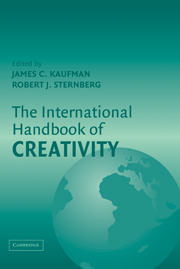Book contents
- Frontmatter
- Contents
- Acknowledgments
- List of Contributors
- 1 Introduction
- 2 Creativity Research in English-Speaking Countries
- 3 Creativity in Latin America
- 4 History of Creativity in Spain
- 5 Past, Present, and Future Perspectives on Creativity in France and French-Speaking Switzerland
- 6 Creativity in Italy
- 7 Creativity Research in German-Speaking Countries
- 8 Creativity Under the Northern Lights
- 9 Creativity in Soviet–Russian Psychology
- 10 Creativity Studies in Poland
- 11 Research on Creativity in Israel
- 12 Creativity in Turkey and Turkish-Speaking Countries
- 13 Development of Creativity Research in Chinese Societies
- 14 Creativity – A Sudden Rising Star in Korea
- 15 Culture and Facets of Creativity
- 16 African Perspectives on Creativity
- 17 Creativity Around the World in 80 Ways … but with One Destination
- Author Index
- Subject Index
- References
16 - African Perspectives on Creativity
Published online by Cambridge University Press: 05 June 2012
- Frontmatter
- Contents
- Acknowledgments
- List of Contributors
- 1 Introduction
- 2 Creativity Research in English-Speaking Countries
- 3 Creativity in Latin America
- 4 History of Creativity in Spain
- 5 Past, Present, and Future Perspectives on Creativity in France and French-Speaking Switzerland
- 6 Creativity in Italy
- 7 Creativity Research in German-Speaking Countries
- 8 Creativity Under the Northern Lights
- 9 Creativity in Soviet–Russian Psychology
- 10 Creativity Studies in Poland
- 11 Research on Creativity in Israel
- 12 Creativity in Turkey and Turkish-Speaking Countries
- 13 Development of Creativity Research in Chinese Societies
- 14 Creativity – A Sudden Rising Star in Korea
- 15 Culture and Facets of Creativity
- 16 African Perspectives on Creativity
- 17 Creativity Around the World in 80 Ways … but with One Destination
- Author Index
- Subject Index
- References
Summary
The fact that Africa has a rich heritage of creative endeavors is hardly contested. For instance, the African continent has some of the world's major historical architectural artifacts, such as the Great Pyramids of Egypt and the Great Zimbabwe National Monument (Zimbabwe). Archeological discoveries have revealed evidence that several ancient African societies were as technologically advanced as any of their time. For example, the Ugbo-Uku works of art in metal, which date back to between the ninth and tenth centuries, were the subjects of acclaimed exhibitions in the United States and Europe in the first half of the 1980s (Oshodi, 2004; Oyowe, 1996). These works and similar others radically changed the international perception of African civilization during these periods. African art and sculpture adorn museums all over the world, and millions of citizens of African countries make a living from artistic productions of many types (Silver, 1981). African creative expressiveness in music, dance, and in the design and use of clothing, ornaments, and human habitats is widely acknowledged (Olaniyan, 2004). Evidence also abounds on the innovativeness of African communities in meeting the demands of living in ecologically rich and highly competitive geocultural environments. For instance, many African communities have distinguished themselves in adapting cultural artifacts and practices from the global community to local needs (Mogaji, 2004a).
Recognition of the importance of creativity by federal or state governments and professional associations varies across the continent. The Nigerian government is a leader in celebrating the significance of creativity to national development.
- Type
- Chapter
- Information
- The International Handbook of Creativity , pp. 456 - 489Publisher: Cambridge University PressPrint publication year: 2006
References
- 8
- Cited by



